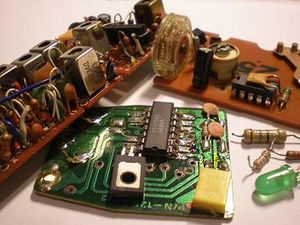Electronics
Electronics is a technology for automation and the basis for modern information technology. For remote controlled explorations and during the setup phase of a settlement on Mars it is required for radio link and data processing.
Vacuum tube
This is the oldest kind of electronic device. It is made from glass and metal. Compared with semiconductor electronics the tubes are big, power consuming, but they are easier to produce. They are radiation-proof, which makes them suitable for long term applications under Martian environmental conditions. Nevertheless, the wear lifespan is limited by abrasion of the heating electrode.
- Vacuum tube are used as switches and amplifier in electronic circuits, with an anode, a cathode and a number of intermediary grids depending on the function.
- Vacuum tubes might be buildable with in situ resources fairly soon in the development of a settlement. So for some applications they might be used rather than electronics. However, if the link with Earth is good, it's unlikely that they will get developpd much.
Semiconductors
Transistors built using semiconductors are the modern form of electronics. They allow ultra-compact devices with low power consumption, but require a hi-tech industry to produce the material and the structures. Since the material is damageable by radiation, it must be shielded carefully and has a limited wear lifespan depending on the intensity of the radiation. The electrical parameters are strongly influenced by the temperature. Note that modern semiconductors are more strongly effected by radiation, older ones (from the 1970's and 1980's are less so). So early Martian fabricators, may choose to create less sophisticated semiconductors as these simpler devices would be more radiation proof.
- Semiconductors require large quantities of energy to refine the materials to the required degree of purity. Therefore until the settlement is large enough to have large amounts of available energy it may be required to import electronics. As the settlements grows more independent, it will require less transportation from Earth. Energy will then become available for other uses, as the fraction of settlement resources dedicated to propellant production goes down. Eventually, local semiconductor production will become economically viable. Note that chips with hundreds or a few thousand transistors per chip are much easier to produce than modern semiconductors with millions of transistors per chip. Such primitive semiconductors are also more resistant to radiation.
- If semiconductors fabricated in Earth orbit become available, it would seem logical that a facility could be built in Mars orbit as well.
Fabrication on Mars
Semiconductors are built for very pure silicon with a dopant added to obtain the required characteristics. Multiple refinement stages are required to obtain the desires purity. The final form of the silicon are 'boules' drawn from a basin of molten silicon and then cut into wafers. As the manufacturing processes improve, the sizes of the boules and the number of transistors that can be etched onto them has grown as well, following an empirical growth formula called Moore's law, with the number of transistors doubling roughly every two years. Silicon is widely available on Mars and the same semiconductors required for transistors are also required for silicon based solar cells. So the demand for solar cells will probably define the market for semiconductors on Mars, and define the required installations for their production.
- Minimal fabs(reference) are a possible alternative to the multi billion dollars semiconductor fabs that exist today, and might be applicable to Mars and the small runs of product required for its industry.







